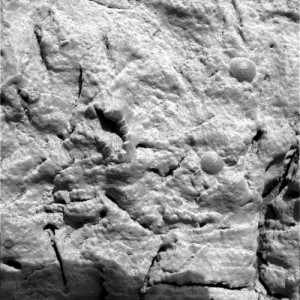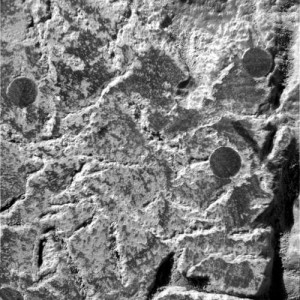NASA Astrobiologist believes evidence of alien life on Mars was destroyed
Astrobiologist Richard Hoover spent more than forty six years working at NASA. In that time, he established the Astrobiology Research Group at the NASA/Marshall Space Flight Center, and became internationally known for his research on microfossils in meteorites. Hoover has published many papers in which he asserts the discovery of extraterrestrial life in meteorites.

Hoover no longer works for NASA, but he continues his controversial research and is currently an astrobiologist at Athens State University and a visiting research professor with the Centre for Astrobiology at the University of Buckingham. Hoover discussed his research in a lecture at the 2014 International UFO Congress. At the event, Hoover sat down with journalist Lee Speigel of the Huffington Post. Speigel asked Hoover to explain what it is that convinces him that life is not restricted to Earth. Hoover responded, “I am absolutely convinced that life is not restricted to the planet Earth because I have found the remains of lifeforms that are absolutely, conclusively extraterrestrial.”
Speigel pointed out that Hoover’s findings have met with harsh skepticism by critics. But Hoover stands behind his research. He replied, “These critics will not debate me in an open scientific forum. I would be perfectly willing to go to the Cosmos Club in Washington, to go to any university and have an academic debate and scientific discussion.”
During Speigel’s interview, he also asked Hoover about a possible organism photographed by NASA’s Opportunity rover. Hoover explained,
Opportunity rover in 2004 took an image of a fascinating structure on Mars that shows structural features that are consistent with organisms on Earth known as crinoids . . . Crinoids are echinoderms, like starfish . . . so these are animals! And I’m saying that Opportunity took a photograph on Mars that shows features that are consistent with what we know of crinoids . . . Now, the fascinating thing is here you have a possible fossil of a very interesting organism in a rock on Mars, and three hours and a half after that photograph was done, that rock was destroyed by the rock abrasion tool.


Hoover claims that he asked NASA astrobiologist David McKay to explain why such an interesting structure was destroyed. He was told that it was done “to look at the inside looking for carbon.” But Hoover has a problem with this answer. He explains, “Well, the problem is, anyone who does much in the field of paleontology knows that you don’t have to find carbon to find fossil.” To further explain his confusion by the decision to destroy a potential fossil, Hoover offered this analogy: “If a paleontologist finds on Earth a rock containing an interesting fossil, they collect it. You would never have a paleontologist say, ‘Gee. That may represent a new genus of life on Earth. Where’s my rock hammer? I want to smash that to bits.'”
Although Hoover is not the first to question this 2004 event, it is interesting to hear the opinion of someone formerly associated with NASA.
You can watch Speigel’s full interview with Richard Hoover in the video at the top of this post.






When I was little around 8 years old I live in Puerto Rico, I remember everybody where coming out of their houses pointing to the sky talking to each other what is that out there and I look they were around five lights look like stars but I knew I was something else . Suddenly they vanished out of no where.
While Hoover’s work goes to great lengths to prove that the structures are not modern contaminants – including exhaustive isolation methods during preparation, noting the fact that the filaments are embedded in freshly fractured rock surfaces, and the fact that their elemental and protein constituents do not match with measured modern biological objects – it does fail to acknowledge the likelihood that the structures, while being native to the meteorite, are in fact abiogenic. As any Precambrian palaeontologist will tell you, identifying cellular fossils in Earth’s rocks is fraught with difficulty. Disentangling true body fossils from abiogenic structures like carbon chains (as in the 3.4Ga Apex Chert, proposed as biogenic by Schopf and Packer in 1987, and subsequently given an abiogenic explanation by Brasier and others in 2002), and carbonate globules (as in the Martian meteorite ALH84001, proposed as biogenic by McKay and others in 1996, and subsequently given an abiogenic explanation by Golden and others in 2001) is an essential and logical part of the scientific process necessary to confirm life in an otherwise barren rock. The biological morphology would also need to be supported with multiple other lines of information – contextual, geochemical and elemental, and the much more likely abiogenic null hypothesis for each supposedly biological signature would need to be first disproved. Only in light of these many lines of robust evidence, could the structures be confidently assigned a biological origin.
Even though UFO exists in our universe and coming near to our earth, why our satellites are not capturing their pictures? and why we are not getting any confirm proof of their existence as our technology is far enough to do so.
Does anyone else notice how time and time again NASA will make sure the rovers inspects rocks that look just like other rocks they just inspected while the very interesting rocks nearby are left untouched.
Is that what a geologist would do? Is that what we pay all this money for? You don’t have to believe there are aliens on Mars to see we are being shortchanged. Let the rovers do something different like look at the unusual rocks and minerals to.
Joe Capp
I find Ms. (or Mr.) Leon’s comment interesting but a bit perplexing. Even if the rock photographed contained an abiogenic structure rather than a true “biological morphology,” what would justify destroying the rock before further analysis could be conducted?
I tend too agree, what justification do they have to destroy an artifact that shows something like a biological creature that might had been fossilized? No fellow fossil hunter would destroy such an artifact if we thought it might have a fossil inside of the rock. I was searching with my dad once in Austin, Texas for fossils, I had thought I found a Dino egg I picked it to show my dad he said it’s wasn’t one but a nice rock anyway. So we kept it as a keep shake for the trip. Since it was my first ever hunt but we never destroyed the rock.
I have followed the exploits of MER Opportunity since day one and I agree that it has come upon a number of curious sites and… curiously, either ground them to dust or rolled on without looking closer.
MSL Curiosity was originally, as I understand it, supposed to be capable of searching for present life on Mars but this capability was, for some reason, rolled back.
Great article.
Hello Jason:
Ever since the days when I was stationed at Malmstrom AFB, in the late 60’s, and the incident that happened at one of the missile silos, I have followed the ufo story. Over the years I have followed the scientists and the reports that they have issued about Martian life. Scientists like the late David McKay, Richard Hoover, Dr. Gilbert Levin and others have shown that life on Mars existed millions of years ago and yet all NASA does is discount their own experts when it comes to life outside earth.
While there is a lot of noise from the NASA officials and the ufo community in general, there is on-going research in the background that will someday vindicate these men about life in the Universe and then we will be faced with a decision,which is, either face it or ignore it at our own peril. Stanton Friedman is more right than he knows when it comes to EBEs visiting our planet.
Great job at Open minds bty Jason, thanks for keeping the public updated!
THE ANSWER to why It was destroyed is sIosimple,to destroy possible proof of life and us finding out,easy
Why do you think we have never found the missing link in the evolution of man kind are we a hybrid from another planet. We are searching for other life forms because is it a trait that survival is essential as just maybe we destroyed our former planet just as we are doing now and will need to find ax new place to call earth. And we will have to genetically change our human traits to adjust to a new enviroment.
Mahendra Ambavale, there have been video recording of UFOs in orbit, leaving Earth’s orbit, and shooting into deep space. Look up, “The Secret NASA Transmissions”. They have also recorded UFOs appearing in Earth orbit on the NASA USTREAM. In fact, the ETs have attempted to communicate with the astronauts and cosmonauts several times which are outlined in the previously mentioned documentary.
Glad everyone is just catching wind of this… been known for a number of years now.